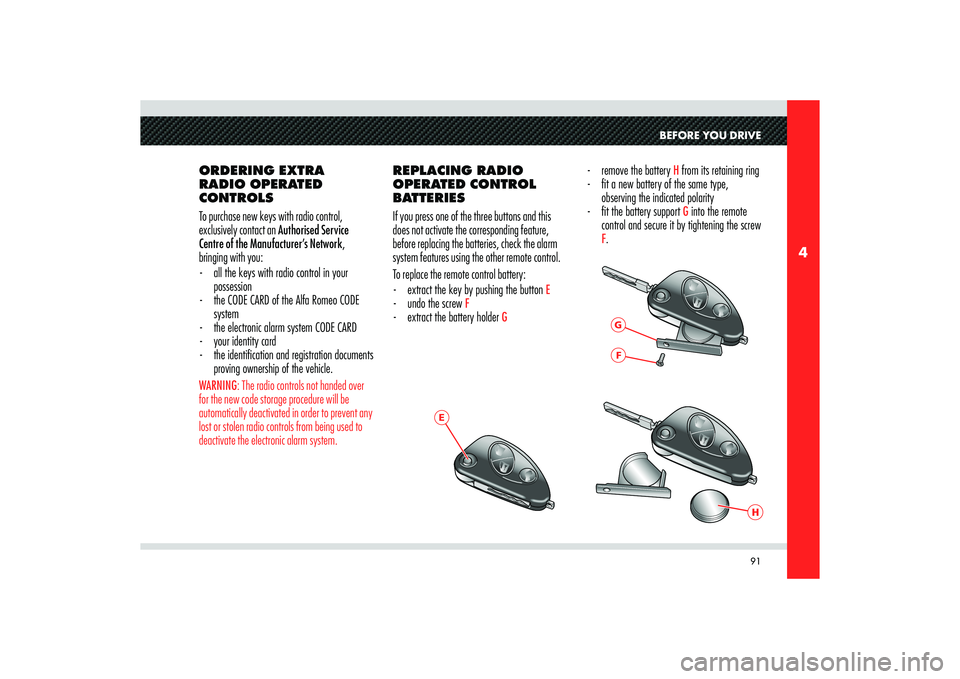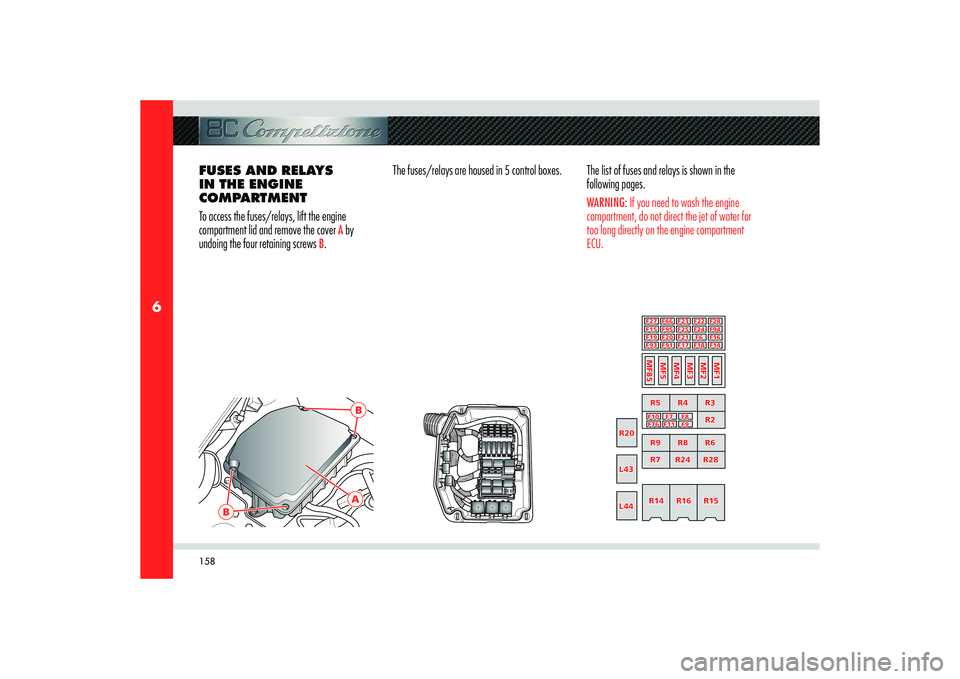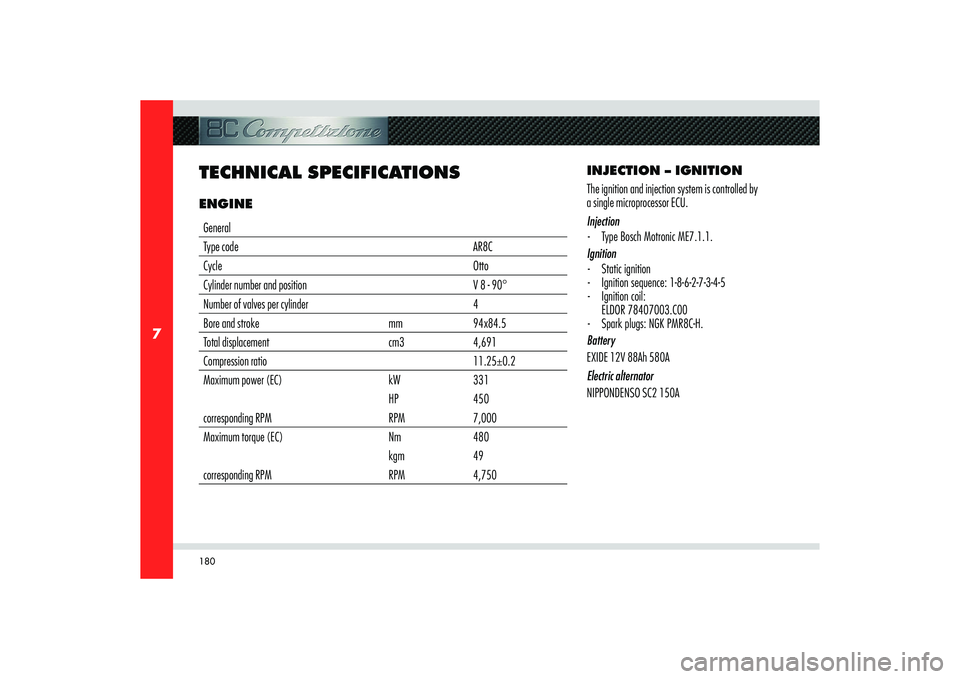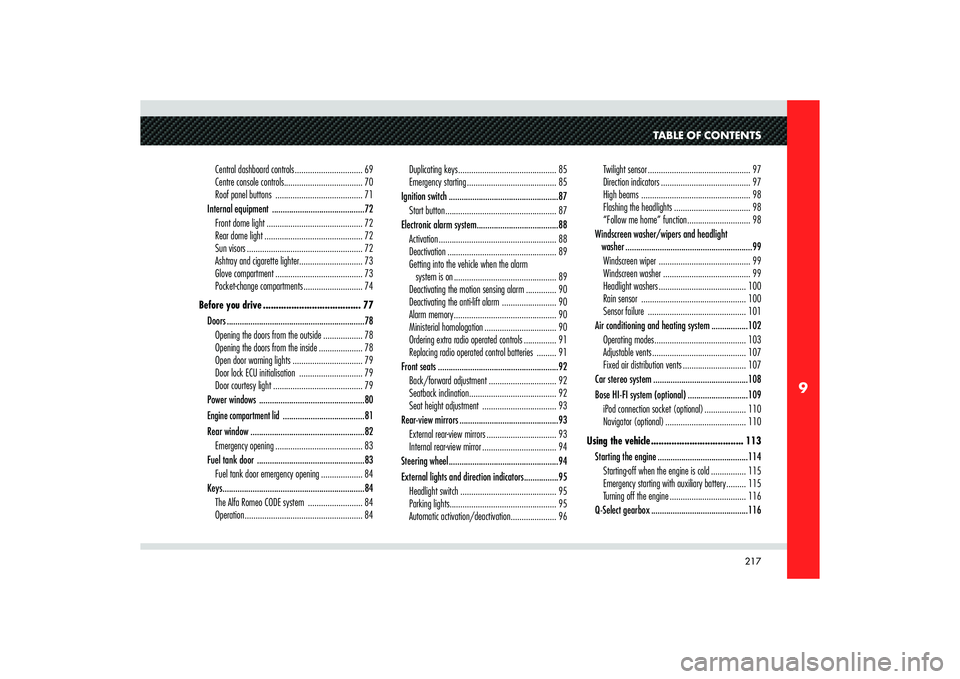ECU Alfa Romeo 8C 2010 Owner handbook (in English)
[x] Cancel search | Manufacturer: ALFA ROMEO, Model Year: 2010, Model line: 8C, Model: Alfa Romeo 8C 2010Pages: 223, PDF Size: 14.35 MB
Page 93 of 223

91
4
E
GF
H
BEFORE YOU DRIVE
ORDERING EXTRA
RADIO OPERATED
CONTROLS
To purchase new keys with radio control,
exclusively contact an Authorised Service
Centre of the Manufacturer’s Network,
bringing with you:
- all the keys with radio control in your
possession
- the CODE CARD of the Alfa Romeo CODE
system
- the electronic alarm system CODE CARD
- your identity card
- the identifi cation and registration documents
proving ownership of the vehicle. WARNING: The radio controls not handed over
for the new code storage procedure will be
automatically deactivated in order to prevent any
lost or stolen radio controls from being used to
deactivate the electronic alarm system.
REPLACING RADIO
OPERATED CONTROL
BATTERIES
If you press one of the three buttons and this
does not activate the corresponding feature,
before replacing the batteries, check the alarm
system features using the other remote control.
To replace the remote control battery:
- extract the key by pushing the button
E
- undo the screw
F
- extract the battery holder
G
- remove the battery
H from its retaining ring
- fi t a new battery of the same type,
observing the indicated polarity
- fi t the battery support G into the remote
control and secure it by tightening the screw
F.
Page 160 of 223

158
6
B
AB
F28
F22
F95
F93F15
F23
F8
MF1R6 R8 R9R28 R7R3
R15 R16 R14 R2
0 R20
L43
R4 R5
R2
MF2
MF3
MF4
MF5
MF85
F7 F10
F9 F11 F76F6 F21 F20 F19
F14 F18 F17 F91R24
F27 F66
F94 F24 F25
F16
L43
L44L44
FUSES AND RELAYS
IN THE ENGINE
COMPARTMENT
To access the fuses/relays, lift the engine
compartment lid and remove the cover
A by
undoing the four retaining screws
B.The fuses/relays are housed in 5 control boxes. The list of fuses and relays is shown in the
following pages.
WARNING: If you need to wash the engine
compartment, do not direct the jet of water for
too long directly on the engine compartment
ECU.
Page 172 of 223

170
6
IF YOU HAVE TO
TOW THE VEHICLE If you need to tow the vehicle, observe the
following recommendations:
- if possible, have the vehicle transported on
a vehicle equipped with loading platform
and specifi c for roadside assistance and
recovery.
If this is not possible:
- Tow the vehicle for a stretch of less than
100 km at a speed below 60 km/h, using
the towing hook provided in the toolkit.To be able to tow the vehicle, you must:
- Turn the ignition key to MAR without
starting the engine (see page 87)
- Engage neutral (position N) by
simultaneously pulling the gearshift paddles
UP and DOWN while holding the brake
pedal depressed (see page 118)
- turn the key back to position STOP.
CAUTION
Do not extract the key, as the
steering wheel will lock automatically
and you will be unable to steer the
wheels.
CAUTION
When towing the vehicle, make
sure that you observe the road traffic
regulations concerning both the towing
device and driving conduct.CAUTION
When towing the vehicle with
the engine off, remember that, without
the assistance of the brake servo, a
stronger effort is required on the brake
pedal for braking and on the steering
wheel for steering.
CAUTION
Screw down the towing hook
into its seat (approx. 11 turns).
Accurately clean the threaded seat
before tightening the hook.
WARNING: If you have to tow the vehicle with 2
wheels raised, ensure that the ignition key is in
the STOP position. Otherwise, when the VDC is
active, the relative ECU will store a malfunction,
which will cause the illumination of the warning
light
on the instrument panel display. This
requires the intervention of an Authorised
Service Centre of the Manufacturer’s Network
to correct the system malfunction.
Page 182 of 223

180
7
TECHNICAL SPECIFICATIONSENGINEGeneral
Type code AR8C
Cycle Otto
Cylinder number and position V 8 - 90°
Number of valves per cylinder 4
Bore and stroke mm 94x84.5
Total displacement cm3 4,691
Compression ratio 11.25±0.2
Maximum power (EC) kW 331
HP 450
corresponding RPM RPM 7,000
Maximum torque (EC) Nm 480
kgm 49
corresponding RPM RPM 4,750INJECTION – IGNITION
The ignition and injection system is controlled by
a single microprocessor ECU.
Injection
- Type Bosch Motronic ME7.1.1.
Ignition
- Static ignition
- Ignition sequence: 1-8-6-2-7-3-4-5
- Ignition coil:
ELDOR 78407003.C00
- Spark plugs: NGK PMR8C-H.
Battery
EXIDE 12V 88Ah 580A
Electric alternator
NIPPONDENSO SC2 150A
Page 201 of 223

199
8
MAINTENANCE
WARNING: If the battery charge remains
below 50% for a long period of time, it will be
damaged due to sulphating: this will reduce its
performance and starting power and the battery
will be more subject to freezing (this can happen
even at -10°C).We recommend that you have the battery charge
condition checked, preferably at the beginning of
the cold season, to prevent the electrolyte from
freezing.
This check should be performed more frequently
if the vehicle is used mainly for short trips or if it
is equipped with power absorbing devices that
remain permanently on even if when the ignition
key is removed. This applies above all if these
devices have been fitted “after market”.
If the vehicle is not used for long periods of time,
please refer to chapter “If the vehicle is laid up
for long periods”, in this section.WARNING: If additional systems have to be
fitted in the vehicle, there is the risk of creating
dangerous branches on the electric wiring, in
particular if the safety devices are involved.
ELECTRONIC
CONTROL UNITSNo special precautions are required for the
normal use of the vehicle.
In the event of repairs to the electrical system
or in an emergency starting, the following
instructions must be strictly followed:
- Never disconnect the battery from the
electrical system when the engine is
running.
- Disconnect the battery from the electrical
system when recharging it (see page 168
“If the battery is fl at”). WARNING: When the battery is disconnected,
you must first detach the negative pole terminal
(–) and then the positive pole one (+).
WARNING: The battery is secured inside the
vehicle by means of a metal box, therefore, be
extremely careful not to let the battery charger
clips come into contact with it.WARNING: When the battery is reconnected,
you must first attach the positive pole (+),
remembering to cover it with the cap provided,
and then the negative one (–).
- Never perform the emergency starting
procedure using a battery charger: always
use an auxiliary battery.
- Take special care when connecting the
battery to the electrical system, checking
both that polarity is correct and that the
connection is properly working.
- Do not connect or disconnect the terminals
of the ECUs when the ignition key is at
MAR.
- Do not check the electric polarities through
sparking.
- Disconnect the ECUs in the event of
electrical welding on the vehicle body.
Remove them if the temperature is
over 80°C (special interventions on the
bodywork, etc.).
Page 202 of 223

200
8
WARNING: Incorrect installation or modifications
to the audio and alarm systems may interfere
with the proper operation of the Electronic
Control Units.
WARNING: Changes or repairs to the electrical
system carried out in an incorrect manner
or without taking into account the technical
specifications of the system may cause operating
malfunctions with the risk of fire.
WARNING: If you need to wash the engine
compartment, do not direct the jet of water for
too long directly on the engine compartment
ECU.
SPARK PLUGSIt is essential that the spark plugs are sound and
clean to help ensure engine performance and to
keep polluting emissions to a minimum level.WARNING: The spark plugs must be changed
at the intervals specified in the Maintenance
Schedule. Only use the recommended spark
plugs: faults may arise if the heat rating is
unsuitable, or if the specified duration is not
guaranteed.
WHEELS AND
TYRESTo obtain the best performances and
the longest tyre life, comply with the
following precautions during the first
500 Km:
- do not drive at maximum
permitted speed
- drive on curves at low speed
- avoid sudden steering
- avoid sudden braking
- avoid sudden accelerations
- do not drive long at high speeds
for too long.
Page 207 of 223

205
8
MAINTENANCE
Normal paint maintenance consists in washing,
the frequency of which depends on the
conditions of use and of the environment.
For example, in areas where there is high
atmospheric pollution or if the roads are spread
with anti-freeze salt, it is advisable to wash the
vehicle more frequently. WARNING: Detergents pollute water. Therefore
the vehicle should be washed in areas equipped
for the collection and purification of the fluids
used for washing.For correct washing:
- Wet the bodywork with a low-pressure
water jet.
- Run a sponge soaked in a neutral detergent
solution over the bodywork, remembering
to rinse the sponge frequently.
- Thoroughly rinse with water and dry with a
jet of air or suede.
When drying, take particular care with the parts
that are less visible, such as the door bays, front
lid, headlight edges, in which water can be
trapped more easily. You are recommended not to take the vehicle
immediately into an enclosed environment, but
leave it in the open air so as to allow the water
to evaporate.
Do not wash the vehicle after it has been left in
the sun or when the hood is hot: the paint gloss
could be affected.
External plastic parts must be cleaned with the
same procedure followed for the normal washing
of the vehicle.
Avoid, as far as possible, parking the vehicle
under trees; the resinous substances that very
often drop from the trees give the paint a dull
appearance and increase the possibility of
originating corrosive processes.
WARNING: Bird droppings must be washed off
immediately and thoroughly, since their acidity is
particularly corrosive.
WARNING: To provide better protection for the
paint, polish the vehicle at regular intervals with
a suitable product leaving a protective film on
the paint.
Windows
To clean the windows use special detergents.
Only use clean cloths so as not to scratch the
windows or rendering them less transparent. WARNING: In order not to damage the electric
elements fitted inside the heated rear window,
rub gently following the direction of the
elements. ENGINE COMPARTMENT
At the end of each winter season, carefully wash
the engine compartment, remembering to not
direct the jet of water for too long on the ECUs
and on the relay and fuse boxes on the right-
hand side of the engine compartment (driving
direction). To perform this operation, you must
contact a specialised workshop. WARNING: Wash only when the engine is cold
and with the ignition key turned to STOP. After
washing, make sure that the various protections
(e.g. rubber boots/caps, guards etc.) have not
been removed or damaged.
Page 219 of 223

217
9
TABLE OF CONTENTS
Central dashboard controls ............................... 69
Centre console controls .................................... 70
Roof panel buttons ........................................ 71
Internal equipment ...........................................72
Front dome light ............................................ 72
Rear dome light ............................................. 72
Sun visors ..................................................... 72
Ashtray and cigarette lighter ............................. 73
Glove compartment ........................................ 73
Pocket-change compartments ........................... 74
Before you drive ...................................... 77
Doors ................................................................78
Opening the doors from the outside .................. 78
Opening the doors from the inside .................... 78
Open door warning lights ................................ 79
Door lock ECU initialisation ............................. 79
Door courtesy light ......................................... 79
Power windows .................................................80Engine compartment lid
......................................81
Rear window .....................................................82
Emergency opening ........................................ 83
Fuel tank door ..................................................83
Fuel tank door emergency opening ................... 84
Keys ..................................................................84
The Alfa Romeo CODE system ......................... 84
Operation ...................................................... 84Duplicating keys ............................................. 85
Emergency starting ......................................... 85
Ignition switch ...................................................87
Start button ................................................... 87
Electronic alarm system ......................................88
Activation ...................................................... 88
Deactivation .................................................. 89
Getting into the vehicle when the alarm
system is on ............................................... 89
Deactivating the motion sensing alarm .............. 90
Deactivating the anti-lift alarm ......................... 90
Alarm memory ............................................... 90
Ministerial homologation ................................. 90
Ordering extra radio operated controls ............... 91
Replacing radio operated control batteries ......... 91
Front seats ........................................................92
Back/forward adjustment ............................... 92
Seatback inclination ........................................ 92
Seat height adjustment .................................. 93
Rear-view mirrors ..............................................93
External rear-view mirrors ................................ 93
Internal rear-view mirror .................................. 94
Steering wheel ...................................................94
External lights and direction indicators ................95
Headlight switch ............................................ 95
Parking lights ................................................. 95
Automatic activation/deactivation ..................... 96Twilight sensor ............................................... 97
Direction indicators ......................................... 97
High beams .................................................. 98
Flashing the headlights ................................... 98
“Follow me home” function ............................. 98
Windscreen washer/wipers and headlight
washer ...........................................................99
Windscreen wiper .......................................... 99
Windscreen washer ........................................ 99
Headlight washers ........................................ 100
Rain sensor ................................................ 100
Sensor failure ............................................. 101
Air conditioning and heating system .................102
Operating modes .......................................... 103
Adjustable vents ........................................... 107
Fixed air distribution vents ............................. 107
Car stereo system ............................................108
Bose HI-FI system (optional) ............................109
iPod connection socket (optional) ................... 110
Navigator (optional) ..................................... 110
Using the vehicle .................................... 113
Starting the engine ..........................................114
Starting-off when the engine is cold ................ 115
Emergency starting with auxiliary battery ......... 115
Turning off the engine ................................... 116
Q-Select gearbox .............................................116